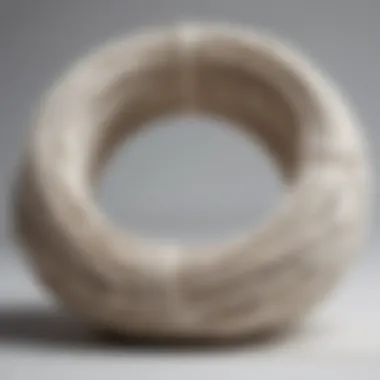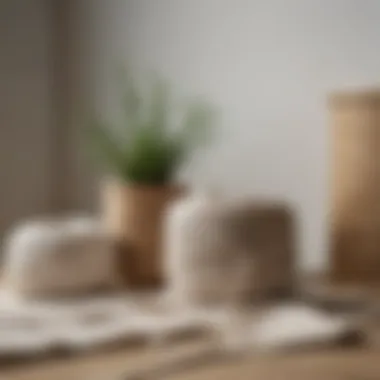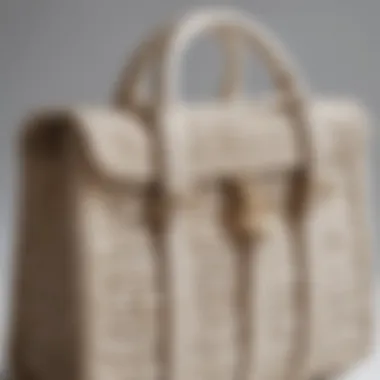Versatile White Jute Twine in Fashion and Design


Intro
White jute twine, often sitting quietly in the background, plays a surprising role in today’s world of fashion and design. Its earthy texture and natural materials beckon creators to consider it beyond its traditional applications. As eco-consciousness shifts from a trend to a necessity, its multifaceted uses demand exploration. Our journey into jute begins with understanding its roots and branching out into its applications in fashion, crafts, and sustainable practices.
Fashion Trends
In recent years, the fashion community has taken notice of white jute twine, weaving it into the fabric of various collections. This shift isn't just about aesthetics; it's driven by a growing desire for sustainable practices without sacrificing style.
Latest Seasonal Trends
Each season brings a wave of new designs, and white jute twine often finds its way into the spotlight. Designers are integrating this robust yet delicate material into their collections.
- Runway Inspirations: Many fashion houses showcase white jute twine in their accessories, be it in handbags, jewelry, or even footwear. Its organic feel contrasts wonderfully with smoother, synthetic fabrics.
- Sustainable Fashion Statements: With the rise of eco-friendly lines, jute has found a niche. Expect to see it braided, knotted, and adorned throughout various collections.
Iconic Styles Revived
This isn't just about new trends; white jute twine is also helping to resurrect styles from the past. Think back to bohemian influences of the 70s, where earthy tones and natural materials ruled the scene. Today’s designers are embracing this nostalgia, but with a modern twist.
- Vintage Inspiration: Accessories from the past are being represented through contemporary materials and techniques, with jute twine lending that authentic vintage charm.
- Comfort Meets Style: Apparel that embodies both comfort and chic is on the rise, with jute accentuating casual wear—think simple shift dresses with a jute belt or a pair of sneakers adorned with jute laces.
Style Tips
Embracing white jute twine in your wardrobe or designs doesn't have to be complex. Here are some ways to incorporate it smoothly into your fashion routine.
How to Mix and Match
One might wonder how to use jute twine without looking overdone. The key is balance.
- Pairing: Combine white jute twine with cotton or linen for a laid-back vibe. It harmonizes beautifully with other textures, making it a versatile companion in crafting outfits.
- Color Coordination: While jute is neutral, play around with vibrant colors to see what compliments shine the most. Tying a bright floral dress with a jute belt can bring an unexpected and refreshing twist.
Dressing for Different Occasions
Flexibility defines jute twine's fashion application.
- Casual Outings: Use a jute twine belt with a pair of high-waisted jeans. Throw in a loose-fitting tee, and you're set for brunch.
- Evening Events: Layer pieces by integrating jute twine into accessories like statement necklaces or a chic handbag. It stands out without overwhelming your entire ensemble.
Finale
In today’s fashion landscape, white jute twine is more than just a humble fiber. As sustainability intertwines with personal expression, jute aligns beautifully with these ideals. From its origins in rugged landscapes to its current day application in fashion statements, it represents a journey towards a more thoughtful way of dressing and creating.
"The best fashion statements come from a place of authenticity and awareness. White jute twine allows us to express ourselves while being mindful of our choices."
With this understanding of jute's versatility, understanding how to incorporate such elements into your designs and wardrobe becomes second nature.
Prelude to White Jute Twine
Understanding the significance of white jute twine sets the stage for a deeper dive into its applications across multiple domains, notably in fashion and crafts. Jute twine, for those who might not know, is a natural fiber made from the jute plant, renowned for both its strength and sustainability. In recent times, there's been a notable surge in the use of sustainable materials in design, making the exploration of white jute twine particularly relevant.
Definition and Characteristics
White jute twine can be defined as a strong, durable cordage derived from the jute plant, specifically crafted for versatile applications. One of its main characteristics is its robust nature, which allows it to withstand various types of uses, from tying and binding to decorative applications. It's often seen as an eco-friendly alternative to synthetic options due to its biodegradable properties. This means that once disposed of, it doesn't contribute to long-term pollution—an appealing aspect for both consumers and designers alike.
Furthermore, the texture of white jute twine gives it an earthy, rustic appeal. Its natural color blends seamlessly with a variety of other materials, making it an attractive addition for fashion accessories or home decor projects. Whether it is being used in macramé designs or as a functional component in bags, its versatility shines through. It's a great canvas for creativity, allowing designers to incorporate personal touches that resonate with consumers seeking stylistic authenticity.
Historical Context of Jute Use
Historically, jute has been cultivated and utilized for centuries, primarily in South Asia. The rich tradition of jute weaving stretches back to ancient times, when it was predominantly used for making durable textiles that could withstand the elements. Jute fibers were often transformed into bags and ropes, serving practical purposes long before the modern fashion industry took notice.
In many cultures, the significance of jute transcends mere functionality. It has been associated with local crafts and economic practices, providing livelihoods to countless communities. The transition to include white jute twine in contemporary applications speaks to its resilience as a material, but also its ability to adapt to modern stylistic demands.
The resurgence of interest in sustainable fashion has brought jute back into the spotlight. Designers today are rediscovering its potential, transforming traditional motifs into modern design elements that speak to both aesthetic sensibilities and ethical considerations. Understanding the history surrounding jute material helps to appreciate its journey from a humble agricultural product to a staple in the fashion toolkit.
The Material Science of Jute


Understanding the material science of jute is fundamental to appreciating its place in fashion and beyond. This section emphasizes the unique attributes of jute as a natural fiber, its sustainability benefits, and its role in innovative design. It sets the stage for why this fiber has become a go-to choice for many designers and artisans aiming for eco-friendly materials.
Natural Fiber Properties
Jute, historically overshadowed by its more glamorous counterparts like silk or cotton, possesses remarkable properties that are especially appealing to contemporary creators. The fiber is naturally strong and durable, which makes it ideal for a variety of applications, from intricate accessories to robust garments.
Key properties of jute include:
- Tensile Strength: Jute boasts impressive tensile strength, allowing it to withstand considerable wear and tear. This factor makes it suitable not just for fashion but also for home goods like rugs and curtains.
- Breathability: Unlike synthetic fibers, jute allows air to circulate, which is particularly beneficial in warmer climates. This natural ventilation serves both fashion and functionality well, ensuring comfort for the wearer.
- Biodegradable Nature: This natural fiber breaks down within a few months when exposed to the elements, easing concerns about environmental impact. Designers can promote a more sustainable choice with jute, tapping into the growing consumer demand for eco-friendly products.
Moreover, the distinct texture of jute gives a rustic yet sophisticated look, making it attractive for both high-end designers and DIY enthusiasts. The available colors vary, but white jute offers a clean slate that pairs well with numerous styles, appealing to various aesthetics and preferences.
Sustainability Aspects
As the world becomes increasingly environmentally conscious, the importance of materials that align with sustainable practices can't be overstated. White jute twine stands out in this regard, offering a myriad of benefits:
- Renewable Resource: Jute is made from the jute plant, which grows rapidly and can be harvested annually. This rapid growth, coupled with minimal agricultural input, stands in stark contrast to synthetic fibers that derive from finite petroleum resources.
- Low Chemical Use: The cultivation of jute often requires fewer pesticides and fertilizers compared to conventional cotton or synthetic alternatives. This practice results in less harm to ecosystems, making jute a sustainable option for conscientious consumers.
- Support for Local Economies: The jute industry is crucial in certain regions, providing incomes for farmers and craftsmen. By choosing jute products, consumers contribute to local economies and promote artisan techniques vital to cultural identity.
"With jute's environmental credentials, it’s no longer just a rustic staple; it’s becoming a fabric that represents a lifestyle choice aligned with values of sustainability and responsibility."
In sum, the material sciences behind jute demonstrate that it is not merely a practical fiber. It embodies a philosophy that dovetails with modern sustainability principles. This knowledge empowers stylists, designers, and marketers to craft narratives around white jute twine that resonate with a growing audience keen on sustainability. By understanding these properties and values, creators can better innovate in their designs, leveraging jute’s unique benefits for both functional and aesthetic purposes.
Applications in Fashion Design
The use of white jute twine in fashion design presents a tapestry of opportunities. This natural fiber not only contributes to the aesthetic appeal but also aligns with the growing inclination towards sustainable and eco-conscious styles. Designers harness the unique textures and visual aspects of jute twine to create fashion statements that are as environmentally friendly as they are stylish. By exploring specific applications, one can appreciate the diverse ways jute twine is redefining contemporary fashion across various accessories and garments.
Using Twine in Fashion Accessories
Belts and Bags
When it comes to accessories like belts and bags, white jute twine shines due to its strength and versatility. Utilizing jute twine in belts provides an organic, rustic touch that stands out in casual and bohemian styles. A well-crafted jute belt can serve as a statement piece, providing a sturdy anchor to any attire while enhancing visual interest.
Jute bags, on the other hand, are becoming increasingly popular for their sustainability. Unlike synthetic alternatives, these bags are biodegradable and contribute to minimal environmental impact. Handcrafted jute bags often feature intricate designs or weaves, showcasing the artisan's skill. They are suitable for both daily use and special occasions, making them a versatile option. However, it's worth noting that the rough texture of jute can sometimes be uncomfortable against bare skin, which may limit its appeal in certain summer fashions.
Shoes and Jewelry
Shoes adorned with white jute twine tell a different yet equally compelling story. Footwear designers are beginning to experiment with this material, often using it to wrap around wedges or as decorative details on sandals. This combination of form and function resonates well with trendsetters looking for chic but sustainable choices. Jute's natural color palette complements various designs, making shoes that utilize this material both simple and striking.
In the realm of jewelry, jute twine plays a unique role too. Bracelets and necklaces made from braided jute can blend with gemstones or metal accents, creating a fusion of natural and contemporary aesthetics. The inherent imperfections of jute lend these accessories a character that polished materials often lack. While some may argue that jute jewelry can be less durable than metal counterparts, its lightweight nature and distinctive look can capture the attention and hearts of many.
Incorporating Twine in Clothing
Trimmings and Embellishments
Using jute twine as trimmings and embellishments opens a door to artistic expression in clothing design. Designers often choose this natural fiber to enhance hems, cuffs, and other details, bringing a touch of nature into the fabric. The rough texture and earthy tones add depth to garments, enabling the wearer to express their individuality.
Aside from aesthetics, the choice of jute trimmings promotes a narrative of sustainability. In a world increasingly focused on eco-friendliness, garments adorned with jute can convey a powerful message. However, the roughness can limit how soft the fabrics feel against the skin, which might deter some consumers.
Functional Elements in Garments
The potential for functional elements in garments crafted from white jute twine is vast. Some designers have started to explore ways to integrate this strong material into functional aspects like drawstrings for hoodies or ties for skirts. Such actions not only make clothing functional but also introduce a handcrafted vibe to ready-to-wear pieces.
The rustic charm of jute twine works especially well in outdoor apparel, aligning itself with adventurous lifestyles. As a result, clothing made with jute ties may provide a balance between practicality and style. Although some might argue that jute isn't the most comfortable fabric for all-day wear, its ecological attributes cannot be dismissed, aligning perfectly with the trend towards ethical fashion.
Crafting with White Jute Twine
Crafting with white jute twine presents a treasure trove of possibilities that enhances both creativity and functionality in various projects. This natural fiber offers an appealing blend of durability and aesthetic charm, making it a go-to choice for a wide array of crafting endeavors. By using white jute twine, crafters can tap into its versatility, creating items that serve practical purposes while also adding a distinctive touch to their surroundings.
DIY Projects for Home Decor
Wall Hangings
Wall hangings made from white jute twine are not just pieces of art; they reflect personal style and ingenuity. The tactile quality of jute provides warmth, making any space feel more inviting. One of the standout characteristics of these hangings is their rustic charm, which seamlessly fits into various design aesthetics, from bohemian to modern.
Using jute twine, one can create intricate patterns and shapes that capture attention without overwhelming a room. A unique feature is the ability to customize these hangings by incorporating beads, colorful threads, or even small mirrors. Not only do they serve as visual statements, but they also contribute to home ambiance by offering texture and depth. However, it’s essential to consider the weight of the decor; heavier additions can compromise the structural integrity of the twine.


Table Centerpieces
Table centerpieces crafted with white jute twine breathe life into dining spaces, infusing them with an earthy and organic feel. Their key characteristic lies in their ability to blend functionality with style; they not only adorn the table but also often serve as a space for candles or floral arrangements.
These centerpieces usually have a natural look, invoking a sense of simplicity that resonates well with many modern aesthetics. A particularly noteworthy benefit is their ease of construction. Even novice crafters can create beautiful designs with a little patience and basic knotting skills. On the downside, it's crucial to ensure the twine does not saturate or absorb moisture from flowers or other arrangements, which could lead to degradation over time.
Functional Craft Applications
Rope Baskets
Rope baskets made from white jute twine provide a practical solution for organizing items with a flair. They're not just storage solutions; they often double as decorative pieces that enhance home decor. The defining characteristic of these baskets is their flexibility; they can be shaped into various sizes to suit the needs of the household.
What sets jute twine baskets apart is their eco-friendliness, allowing eco-conscious consumers to reduce their carbon footprint while enjoying a stylish option for storage. They are lightweight yet strong enough to hold various contents. However, one must consider how they are used; baskets exposed to high humidity may experience wear faster than anticipated.
Gift Wrapping Techniques
Gift wrapping using white jute twine brings a rustic twist to the often mundane task of wrapping presents. This technique stands out because it offers a robust, natural appeal that elevates even the simplest gift. The earthy tones of jute provide a beautiful contrast when paired with colorful wrapping paper or fabric.
One remarkable feature is the versatility in tying styles—ribbons, bows, or even simple knots can be incorporated, making each gift feel unique and well thought out. Still, a big thing to remember is that while jute twine is sturdy, it can be more challenging to manipulate compared to traditional ribbons or wrapping materials; careful handling ensures a neat finish.
Crafting with white jute twine offers an abundance of creative outlets that can enrich personal expression while contributing positively to the environment. By exploring these DIY projects and functional applications, individuals can find numerous ways to incorporate this versatile material into their lives.
Cultural Significance of Jute Twine
The role of white jute twine transcends mere utility, weaving itself into the rich tapestry of various cultures. Its significance can be seen through traditional practices and modern interpretations, illustrating both historical roots and contemporary relevance. Delving into these aspects can reveal the broader narrative of how a simple material like jute can embody cultural identity and craftsmanship.
Traditional Uses Across Cultures
Regional Craft Trends
Across different regions, jute twine has been a staple in artisan crafts. For instance, in Bangladesh and India, skilled artisans employ jute twine to create intricate handicrafts. One notable trend is the use of jute twine in macramé, where it weaves vibrant pieces that are not just decorative but also functional, serving as wall hangings and plant holders. This trend highlights the durability of jute, making it a popular choice among craftsmen aiming for sustainability.
"Incorporating jute twine in regional crafts contributes not just to aesthetic appeal but also to a sustainable way of living."
The key characteristic of these craft trends is their commitment to preserving tradition while tapping into modern tastes. By embracing jute, artists effectively showcase natural fibers, often connecting buyers to the product's heritage. However, some artisans face challenges, as the demand for cheaper synthetic alternatives can overshadow the intricate quality of handwoven pieces—with this, they risk losing their cultural signature in the process.
Cultural Rituals and Celebrations
Jute twine is also woven into cultural rituals, particularly in festive times. In rural areas of India, for example, jute is often included in wedding trousseaus, symbolizing simplicity and prosperity. During harvest celebrations, jute crafts become an integral part of decorations, linking communities to their agrarian roots.
The unique feature here is the emblematic nature of jute during these rituals. It represents not only the fertility of land but also a connection to generations past. While many associate luxury with modern materials, these traditions ground celebratory practices in authenticity—a crucial aspect that appeals to those valuing ethical choices in fashion.
On the downside, as cultural rituals evolve, there’s a risk of these practices becoming diluted, losing their essence in favor of more commercial approaches. Balancing the pulse of traditions while keeping up with modernity is a delicate act for many artisans.
Modern Interpretations in Fashion
Artisan Collaborations
As fashion trends shift, collaborations with artisans skilled in using jute twine have burgeoned. Many designers are seeking to integrate traditional craftsmanship into contemporary fashion, resulting in a fusion that not only innovates style but also tells a story of cultural significance. An admirable aspect of these collaborations is the effort to preserve age-old techniques while making them relevant to today’s fashion landscape.
One unique feature is the combination of jute twine with luxury materials. This not only elevates the perception of jute but also imbues pieces with a distinct narrative, appealing to an audience that appreciates craftsmanship and sustainability. Yet, the challenge here lies in maintaining the integrity of traditional practices amidst a fast-paced fashion industry, which often seeks instant gratification.
Contemporary Fashion Trends
Modern fashion is witnessing a surge in appreciation for eco-friendly and sustainable materials, and jute twine stands at the forefront. Current trends highlight its use in accessories such as bags, where the tactile nature of twisted jute adds a rustic elegance. As consumers grow more conscious of their environmental footprint, the versatile nature of jute aligns perfectly with this shift.
The key characteristic of contemporary fashion trends is the blending of sustainability with aesthetics. Designers are crafting pieces that are not only visually appealing but also convey an ethical message. However, one must be cautious—while the trend is promising, there could be a risk of jute being marketed without adequate understanding of its cultural context, which might commercialize its deeper significance.
In summary, white jute twine showcases a rich cultural significance that bridges the gap between traditional uses and modern interpretations, providing a timely narrative in both fashion and craft. By navigating its past and present, the journey of jute twine reveals intertwined stories of identity, sustainability, and creativity.
Environmental Impact and Ethical Fashion
In today’s world, understanding the ecological and ethical implications of fashion materials is pivotal. The rise of fast fashion has ushered in a crisis—overconsumption and waste have come to define the industry. In this context, white jute twine emerges as a commendable alternative. Its precious materials not only cater to aesthetic needs but also align with sustainable practices that benefit our environment and society.
Biodegradability and Ecological Benefits


One of the standout features of jute, particularly white jute twine, is its natural biodegradability. Unlike synthetic fibers which can linger in landfills for decades, jute decomposes efficiently. When disposed of, jute breaks down within a few months returning nutrients to the soil. This unique property is crucial in reducing overall waste and mitigating environmental damage.
Additionally, jute requires relatively low amounts of water and no harmful chemicals during its cultivation. As a result, using white jute twine not only lessens the environmental footprint but also supports a healthier ecosystem.
Studies have shown that cultivating jute can actually help improve soil health, making it a valuable crop in sustainable agriculture.
This aspect of jute aligns well with eco-conscious trends, making it a darling amongst designers and consumers who value sustainability in their fashion choices.
Support for Local Economies
The production of jute, especially in developing regions, serves as a lifeline for many communities. When purchasing fashion items featuring white jute twine, consumers can actively contribute to supporting local economies. Many small-scale farmers depend on jute cultivation for their livelihoods, thus investing in jute products creates demand, helps sustain local industries, and nurtures economic independence.
Furthermore, as the awareness around eco-friendly materials increases, so does the appreciation for artisan craft. Collaborations between designers and local farmers can lead to the creation of unique, handcrafted products that tell stories of their origin. This not only promotes fair trade practices but also elevates the perceived value of the craftsmanship involved.
In summary, the environmental impact of white jute twine extends beyond its biodegradable nature—it's intricately linked to enhancing sustainable practices and uplifting communities worldwide. As consumers become more discerning, the demand for such materials becomes a powerful tool in shaping a more ethical and sustainable fashion landscape.
Consumer Awareness and Trends
Understanding consumer awareness and trends is vital in the context of white jute twine. As the fashion landscape shifts towards sustainability, consumers are increasingly making conscious decisions about the materials they support. This section aims to explore the dynamics of consumer preferences, the growing market for sustainable materials, and how these trends influence decisions in design and purchasing.
Market Demand for Sustainable Materials
The demand for sustainable materials in the fashion industry has seen a significant uptick in recent years. As consumers become more environmentally aware, their choices are influenced by how materials impact the planet. White jute twine, known for its durability and biodegradability, has emerged as a key player in this shift.
Some factors contributing to this rise in demand include:
- Eco-conscious Values: Consumers now prioritize brands that align with their environmental values. The rise of social media platforms means that decisions are often informed by collective advocacy for sustainability. A single post on Facebook showcasing a harmful environmental impact can sway public opinion rapidly.
- Transparency in Production: Shoppers are looking for brands that provide transparency about where and how materials are sourced. Companies that promote fair trade practices or local sourcing often gain consumer trust, which is crucial in today’s marketplace.
- Quality Over Quantity: There’s a notable shift from fast fashion towards investing in quality items made from sustainable materials. Jute twine products often promise durability, giving consumers more value for their money, reducing the need for frequent replacements.
Evolving Consumer Preferences
Evolving consumer preferences are shaping the industry's response to sustainability. Fashion lovers today are not just looking for trendy items; they're after pieces that reflect their personal values and beliefs. This shift has various implications:
- Personal Expression: Items made from white jute twine allow consumers to express their individual style while staying true to their eco-friendly ethos. Unique accessories and clothing pieces that highlight this material can stand out, minimizing the wear and tear from fast-fashion trends.
- Cultural Relevance: As awareness of cultural heritage grows, consumers often favor products that tell a story. White jute twine is not just a product; it’s a medium of expression that resonates with traditional craftsmanship and modern aesthetics alike.
- Innovation in Design: Designers are adapting to these preferences by creating innovative products incorporating white jute twine. The material’s versatility opens up new avenues for creativity, appealing to a demographic that values both novelty and durability.
"The shift towards sustainable materials is not merely a trend; it's a reflection of our evolving values as a society. By embracing materials like white jute twine, consumers participate in a larger movement towards ethical fashion."
The Future of White Jute Twine in Fashion
The sustainability movement is gathering steam, and white jute twine finds itself at the heart of this evolution in the fashion arena. Its versatility and eco-friendly properties position it as a strong competitor against synthetic fibers. As consumers become more conscious of what they wear and its origins, the demand for sustainable materials like jute is likely to soar. This section will dig deeper into innovative design techniques that harness the natural beauty of jute while also looking at potential challenges and limitations that the industry must navigate.
Innovative Design Techniques
Designers are beginning to get creative with white jute twine, pushing the boundaries of traditional applications. The unique texture and earthy tone can be effectively used for:
- Unique Textiles: Some designers are experimenting with weaving jute strands into fabric, creating a distinct look that aligns with bohemian and rustic themes.
- Layering: Incorporating jute as a layering element adds both depth and tactile interest to garments. Imagine a dress with a flowing fabric alongside rough jute accents.
- Sustainable Techniques: Techniques such as natural dyeing can enhance jute’s aesthetic appeal without compromising its eco-friendly nature. Shades drawn from natural sources can complement its earthy texture beautifully.
Such innovative approaches make white jute a desirable option for contemporary fashion. The material can be transformed into chic handbags, stylish belts, or even dramatic, sculptural pieces that make a bold statement. Designers need to showcase the adaptability of jute in various styles, making it not merely eco-friendly but also fiercely fashionable.
Potential Challenges and Limitations
While the future of white jute twine in fashion appears bright, several challenges remain. Understanding these hurdles would not only help designers strategize better but also prepare consumers for potential limitations in their sustainable fashion choices. Here are a few considerations:
- Durability Concerns: Jute is not as durable as some synthetic materials. Its longevity in high-stress applications—like those seen in athletic wear—may come into question.
- Market Perception: There's often a stigma that comes with natural fibers. They are sometimes associated with roughness or being less sophisticated. Designers must educate consumers on how jute can fit in high-fashion contexts.
- Availability and Cost: Sourcing quality jute can sometimes be an issue. Prices fluctuate based on quality, terrain, and global ties. Cost-effective options that also maintain quality may be hard to find.
- Care Instructions: While jute is biodegradable, it also has specific care needs. Consumers may need to change their washing and maintenance habits, which can be a hurdle in mainstream adoption.
To sum it up, while there are clear paths to infusing white jute twine into modern fashion, several challenges must be tackled. The journey forward involves combining creativity with practicality, establishing a balanced perspective that respects both fashion sensibilities and environmental consciousness.
Ending
In wrapping up our exploration of white jute twine, it becomes clear that this simple material holds a wealth of potential in diverse fields from fashion to crafts and beyond. The use of white jute twine brings not just aesthetic appeal but also underscores a significant movement toward sustainability in design. Its natural origins and biodegradable properties resonate with today’s eco-conscious consumer, making it a compelling choice for designers looking to merge beauty with responsibility.
Recapitulation of Key Points
To summarize, we've navigated several key areas:
- Material Characteristics: White jute twine is appreciated for its strength and versatility, allowing it to be used in everything from garments to home decor.
- Cultural Context: This fiber has stood the test of time, rooted deeply in various traditions across the globe, yet remains relevant today.
- Sustainability: The push towards eco-friendly fashion has highlighted jute’s benefits, significantly lowering environmental impact compared to synthetic alternatives.
- Fashion Applications: We’ve seen creative uses of jute twine in accessories and clothing, showcasing its ability to add unique touches that elevate any outfit.
- Future Directions: Emerging trends indicate a bright future for jute in innovative designs and sustainable practices in the fashion industry.
Final Thoughts on Jute’s Role in Fashion
As we step into a more mindful era of fashion, the role of white jute twine continues to evolve. Its ability to blend seamlessly into modern aesthetics while promoting sustainable practices sets it apart in a crowded marketplace. Designers and consumers alike are increasingly recognizing the value of materials like jute, which speak not only to personal style but also to broader ethical considerations.
The journey of white jute twine from a simple agricultural product to a staple in sustainable fashion is fascinating. Moving forward, it's imperative for those in the industry to keep pushing boundaries, fostering a culture that values quality and sustainability over transient trends.















